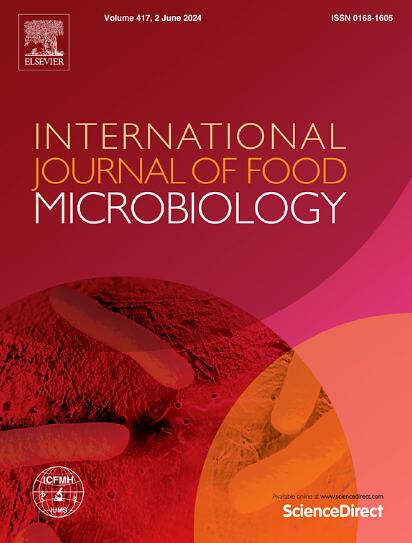多菌灵对酿酒酵母S-189代谢途径及啤酒特性的影响
IF 5.2
1区 农林科学
Q1 FOOD SCIENCE & TECHNOLOGY
International journal of food microbiology
Pub Date : 2025-04-23
DOI:10.1016/j.ijfoodmicro.2025.111219
引用次数: 0
摘要
多菌灵(CBZ)是一种广泛应用于农业生产的杀菌剂,但其残留会污染啤酒原料,对酿酒酵母和啤酒品质造成潜在影响。本文研究了CBZ对酿酒酵母S-189 (S-189)及啤酒品质的影响。结果表明,浓度等于或大于150 μg/kg的CBZ对S-189有抑制作用,抑制了S-189的生长速度、细胞数量和活力,破坏了细胞结构。CBZ破坏S-189的多种代谢途径,包括氨基酸生物合成、tRNA生物合成和ABC转运蛋白,并对能量代谢、抗氧化活性、营养物质运输和发酵性能产生负面影响。与对照组相比,300 μg/kg cbz污染麦汁发酵后的啤酒发酵度、酒精含量和总酸度降低,啤酒的真浓度、pH、浊度和醇酯比升高。此外,CBZ改变了啤酒中关键风味物质的含量,影响了啤酒的风味品质。本文章由计算机程序翻译,如有差异,请以英文原文为准。
The effects of carbendazim on metabolic pathways of Saccharomyces cerevisiae Saflager S-189 and beer characteristics
Carbendazim (CBZ) is a broad-spectrum fungicide commonly used in agriculture, but its residue can contaminate beer ingredients, potentially affecting Saccharomyces cerevisiae and beer quality. In this work, the effect of CBZ on Saccharomyces cerevisiae Saflager S-189 (S-189) and beer quality was investigated. The results demonstrated that S-189 was inhibited at concentrations equal to or exceeding 150 μg/kg of CBZ, reducing its growth rate, cell number, viability, and damaging cell structure. The CBZ disrupted multiple metabolic pathways in S-189, including amino acid biosynthesis, tRNA biosynthesis, and ABC transporters, and negatively affected energy metabolism, antioxidant activity, nutrient transport, and fermentation performance. Compared with the control group, the fermentation degree, alcohol content, and total acidity of beer fermented with 300 μg/kg CBZ-contaminated wort decreased, while the true concentration, pH, turbidity, and alcohol-ester ratio increased. Furthermore, CBZ changed the content of key flavor substances in beer, which affected the flavor quality of beer.
求助全文
通过发布文献求助,成功后即可免费获取论文全文。
去求助
来源期刊
CiteScore
10.40
自引率
5.60%
发文量
322
审稿时长
65 days
期刊介绍:
The International Journal of Food Microbiology publishes papers dealing with all aspects of food microbiology. Articles must present information that is novel, has high impact and interest, and is of high scientific quality. They should provide scientific or technological advancement in the specific field of interest of the journal and enhance its strong international reputation. Preliminary or confirmatory results as well as contributions not strictly related to food microbiology will not be considered for publication.

 求助内容:
求助内容: 应助结果提醒方式:
应助结果提醒方式:


